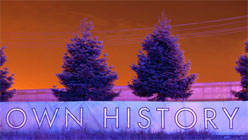The Headlands Center for the Arts is a unique Bay Area jewel hidden away in the rolling hills of the Marin Headlands. It is a multidisciplinary artists residency program housed in a former military barracks, set against the backdrop of the Pacific Ocean and the wild coastline of the Golden Gate Recreational Area. The current group exhibition features twenty artists and is titled De-Mobbing, military slang for de-mobilization, the systematic withdrawal of troops from occupied territory, such as is the case this year in Iraq and Afghanistan. It is a conceptually loaded term freighted with significance, but this group exhibition navigates away from an overly didactic interpretation to explore broader ideas related to history, landscape, and personal narrative.
More than thirty years ago artists Ann Hamilton, David Ireland, Bruce Tomb, and John Randolph were instrumental in the renewal of these historic 1907 buildings as community sites for artists to explore new ideas surrounded by the natural landscape and the residue of history. In as much as this site functions as a peaceful sanctuary now, it also retains salient features of its original purpose — one former resident, artist Elizabeth Demaray, fashioned a fuzzy tea cozy for a defunct 10-ton nuclear missile on site. These juxtapositions of art and war and life and history present fertile ground from which to consider our evolving relationship to military engagement.

Standing Position 1, Whitney Lynn, 2010; courtesy Robert Diver Herrick.
Some of the work in De-Mobbing integrates into the surroundings like found relics. Whitney Lynn’s Authentic Replica (2010) presents a diminutive child-sized mannequin clad in the artist’s own childhood replica F-106 flight suit, a poignant display of soft-core military propaganda packaged for the tiniest of patriots. It is set opposite Standing Position 1 (Sitting Pretty (2012), a life-sized fort-like structure assembled from cast-off objects sourced around the Headlands including an upturned sink and old drapery; this work is also by Lynn, in collaboration with her graduate students in the New Genres program at the San Francisco Art Institute. A light within the interior beckons, but there is no discernable point of entry.
Jessica Cadkin’s white satin soft sculptures, representative of Civil War weapons and Winchester rifles, hang nearby like ghostly specters and summon a long American history with conflict. Contrastingly, Cameron Hockenson’s Reproduction Cycle (2010) is a floor-based installation of sculpturally repurposed shipping pallets, scorched into charcoal. Hockenson’s sculptural forms complicate the plausible ‘scorched earth’ reference here by also pointing to the destruction of art and other cultural artifacts as a wartime commonality.


